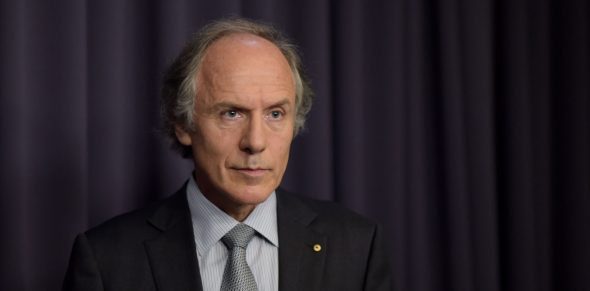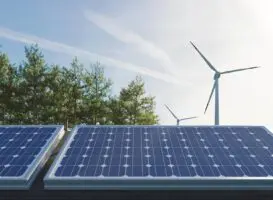Australia’s chief scientist has called for the adoption of a “technology neutral” Clean Energy Target, the staggered “orderly” closure of existing coal and gas plant, and tighter governance of the incumbent power generation sector, as key planks for reform in his major review of Australia’s troubled energy market.
The highly anticipated report – tabled by Alan Finkel on Friday, eight months after it was commissioned following the system black event in South Australia in late September – tackles the key issues of electricity supply cost, security and reliability, as the nation transitions away from fossil fuels and towards distributed renewable energy generation.
And the overriding message from Dr Finkel is clear: “To achieve this…. we need a plan.”
Crucially, says Finkel, this plan must be based on a national emissions reduction trajectory that everyone – Australian, state and territory governments from both sides of the political spectrum – agrees to.
But his modelling, and his policy suite, is based only on the Coaliton’s modest target of a 28 per cent cut in emissions below 2005 levels by 2030, heading towards zero emissions only in the second half of the century (2070).
Finkel said in his report on Friday that he and his Review Panel – which included Chloe Munro, Karen Moses, Mary O’Kane and Terry Effeney – had quickly discovered that “beyond the cost of gas, uncertainty around emissions reduction policies was pushing up prices and undermining reliability.”
“Our plan removes that uncertainty,” he said.
The plan’s key feature is an “orderly transition” that would bring new generation – based on low emissions, not technology type – into the national electricity market to improve reliability.
“There are no prohibitions, just incentives,” Finkel said.
The report argues that bringing new generation into the market at lowest cost, and without “prematurely displacing” existing coal and gas plants, will put downward pressure on prices, while also reducing emissions.
So while the existing Renewable Energy Target will continue to its scheduled 2020 end, the report recommends that it should not be extended, but replaced with a Clean Energy Target.
The CET, rather than incentivising the roll-out of more large-scale renewable energy capacity, would have a goal of lowering long-term emissions:
“For example, a mix of wind, solar and coal generation would be equally acceptable as a mix of wind, solar and gas generation as long as the emissions reduction trajectory is achieved,” the report says.
However, the modelling suggests that it will throw coal a lifeline, and it will still account for more than one quarter of Australia’s generation by 2050, with large scale renewable energy only reaching 33 per cent by 2030.
This is despite the reports recognition that renewable energy, wind and solar in particular, are cheaper than new fossil fuel technologies, even with storage attached. The costings do not include a price on emissions or environmental impacts.
Under the Clean Energy Target, the report recommends that existing large electricity generators be required to give three years’ notice of closure, to signal investment opportunities for new generation and give communities time to adjust to the loss of a large employer.
It would also place obligations on new generators to provide essential services to maintain voltage and frequency, as well as to guarantee supply of electricity as determined by the market operator.
This last point is a nod to the fact that renewable energy generation is not the only type subject to variability, with some of the nation’s key coal and gas plants repeatedly failing to deliver during periods of peak demand over the past summer.
However, in one of the most controversial aspects of the report, it recommends that the responsibility for dispatchability falls on individual generators, including wind and solar farms, rather than a system wide protocol, although the level of “dispatch ability will be decided by market regulators.
Reliability would be further ensured, the report adds, by introducing the means to financially reward consumers for participating in demand response and distributed energy and storage – a path that AEMO and ARENA are currently exploring through their 100MG demands response trial.
Along with an orderly transition, the energy market blueprint also recommends strengthened governance and system planning – the three pillars whose support is crucial, it says, to prevent the NEM from stumbling again in future.
On “system planning,” the report recommends a system-wide grid plan to inform network investment decisions and ensure security is preserved in each region.
Notably, this would include a list of potential “priority projects”, the report says, that would enable development of “renewable energy zones.”
Perhaps more notably, Finkel’s modelling also shows that the CET would result in more coal power than business as usual, a finding that will no doubt satisfy the federal Coalition government and the powerful fossil fuel lobby that still appears to have a major hold over the party’s right-wing rump.
This finding is tempered, however, by a note reminding policy-makers “that the current massive transformation in the operation of the electricity market is not driven solely by decisions of individual governments, no matter how large.
“It is driven by international trade competitiveness, innovation, business appetite for lower costs, competition to drive new technology, and consumers’ desire to take greater control of their energy costs and do their bit for the environment,” Finkel says in the preface to the report.
The report also calls for the establishment of an Energy Security Board, which it says would drive implementation of the blueprint and deliver an annual health check on the state of the
NEM.
Other key recommendations:
*By mid-2018, the COAG Energy Council should direct the Australian Energy Market Commission to review the regulatory framework for power system security in respect of distributed energy resources participation.
*By mid-2019, the Australian Energy Market Commission should report to the COAG Energy Council on proposed draft rule changes to better incentivise and orchestrate distributed energy resource participation to provide services such as frequency and voltage control.
*The Australian Government should lead a process to regularly assess the National Electricity Market’s resilience to human and environmental threats. This should occur by mid-2019 and every three years thereafter.
*By 2020, the Australian government should develop a whole-of-economy emissions reduction strategy for 2050.
*By end-2017, the Australian Energy Market Operator should require generators to provide information on their fuel resource adequacy and fuel supply contracts, to enable it to better assess fuel availability.
*By mid-2018, the COAG Energy Council or the Australian Energy Market Commission should commission financial modelling of the incentives for investments by distribution network businesses, to test if there is a preference for capital investments in network assets over operational expenditure on demand-side measures. If this work demonstrates that there is a bias towards capital expenditure, the COAG Energy Council should direct the Australian Energy Market Commission to assess alternative models for network incentives and revenue-setting, including a total expenditure approach. This should be completed by end-2019.
(This story will be updated)












